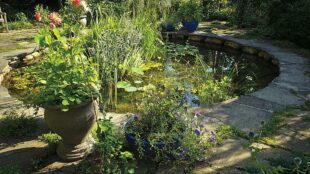Introduction
 Throughout my life, I’ve had the pleasure of creating and nurturing small garden ponds. These serene aquatic ecosystems have been more than just ornamental features in my yard; they’ve been windows into a vibrant world teeming with life. I’ve come to appreciate that these ponds are not just about aesthetics; they play a vital role in bolstering biodiversity and supporting local wildlife.
Throughout my life, I’ve had the pleasure of creating and nurturing small garden ponds. These serene aquatic ecosystems have been more than just ornamental features in my yard; they’ve been windows into a vibrant world teeming with life. I’ve come to appreciate that these ponds are not just about aesthetics; they play a vital role in bolstering biodiversity and supporting local wildlife.
The Magic of Biodiversity
Biodiversity, simply put, is the variety of life forms in a particular habitat or ecosystem. It’s not just about having a wide array of species; it’s about the intricate interplay between them. As I’ve watched my garden mini-lakes evolve over the years, I’ve marveled at how they’ve become miniature hubs of biodiversity, each one a unique and thriving ecosystem.
1. Diverse Plant Life
A key element in promoting biodiversity in garden ponds is the careful selection of aquatic and marginal plants. From the elegant water lilies to the feathery submerged vegetation, these plants offer shelter and food for a plethora of creatures. Frogs and tadpoles hide among the leaves, insects lay their eggs on the surface, and fish find refuge from predators in the underwater foliage.
2. Attracting Amphibians

Speaking of frogs, these amphibians are some of the most charming and beneficial residents of a water feature. I’ve watched tadpoles transform into adults and take up residence near the water’s edge. Not only are they delightful to observe, but they also play a crucial role in controlling insect populations. Their tadpoles feed on algae and provide a food source for other pond inhabitants.
3. A Haven for Insects
Insects, both aquatic and terrestrial, are drawn to ponds like magnets. Dragonflies and damselflies are iconic waterhole visitors, their nymphs living underwater before emerging as adults. In turn, these elegant insects are natural predators of mosquitoes, helping to keep their populations in check. Moreover, ponds/lakes attract a wide variety of other insects, which in turn support birds and bats that feed on them.
4. Nourishing Local Birds
One of the most rewarding aspects of pond ownership is observing the diverse birdlife that visits. Water-loving species such as ducks, herons, and kingfishers are frequent guests, while songbirds come to drink and bathe. Birdsong fills the air, creating a harmonious atmosphere that transcends the visual beauty of the pond.
5. Beyond the Pond
 Garden ponds don’t just confine their influence to their watery borders. They contribute to the broader ecosystem by providing water sources and habitat for nearby wildlife. In hot weather, birds and small mammals rely on these mini lakes for drinking and bathing. Bees and other pollinators come to sip water, and deer and other larger animals visit for a drink. Your pond can become a focal point for the local wildlife community.
Garden ponds don’t just confine their influence to their watery borders. They contribute to the broader ecosystem by providing water sources and habitat for nearby wildlife. In hot weather, birds and small mammals rely on these mini lakes for drinking and bathing. Bees and other pollinators come to sip water, and deer and other larger animals visit for a drink. Your pond can become a focal point for the local wildlife community.
Conclusion
Building and caring for garden ponds isn’t just a hobby; it’s a means of strengthening biodiversity and supporting local wildlife. It’s about creating a space where creatures of all sizes and shapes can thrive, where the ecosystem’s delicate balance is a testament to nature’s wonders. As someone who has nurtured these ponds throughout my life, I’ve experienced the joy of being a steward of biodiversity right in my own backyard. These water features are not just water features; they’re living, breathing showcases of the intricate web of life. So, if you’re contemplating adding a pond to your garden or you already have one, remember that it’s more than a picturesque addition – it’s a sanctuary for biodiversity and a testament to your love for these watery wonders.
Pro Tip: Create hiding spots and shelter near your pond using rocks and aquatic plants to attract frogs. These provide safety and breeding opportunities, encouraging frogs to make your pond their habitat and boosting your pond’s ecological diversity.
